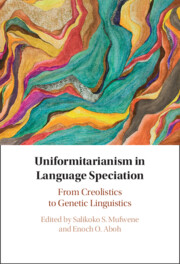Metrics
Full text views
Full text views help Loading metrics...
Loading metrics...
* Views captured on Cambridge Core between #date#. This data will be updated every 24 hours.
Usage data cannot currently be displayed.

Uniformitarianism is the widely held assumption that, in the case of languages, structural and other changes in the past must have been triggered and constrained by the same ecological factors as changes in the present. This volume, led by two of the most eminent scholars in language contact, brings together an international team of authors to shed new light on Uniformitarianism in historical linguistics. Applying the Uniformitarian Principle to creoles and pidgins, as well as other languages, the chapters show that, contrary to the received doctrine, the former group of languages did not emerge in an exceptional way. Covering a typologically and geographically broad range of languages, and focusing on different contact ecologies in Africa, Latin America, and the Caribbean, the book also dispels common misconceptions about what Uniformitarianism is. It shows how similar processes in different ecosystems result in different linguistic patterns, which don't require exceptional linguistic explanations in terms of creolization, pidginization, simplification, or incomplete acquisition.
 Loading metrics...
Loading metrics...
* Views captured on Cambridge Core between #date#. This data will be updated every 24 hours.
Usage data cannot currently be displayed.
This section outlines the accessibility features of this content - including support for screen readers, full keyboard navigation and high-contrast display options. This may not be relevant for you.
The PDF of this book is known to have missing or limited accessibility features. We may be reviewing its accessibility for future improvement, but final compliance is not yet assured and may be subject to legal exceptions. If you have any questions, please contact accessibility@cambridge.org.
Allows you to navigate directly to chapters, sections, or non‐text items through a linked table of contents, reducing the need for extensive scrolling.
Provides an interactive index, letting you go straight to where a term or subject appears in the text without manual searching.
You will encounter all content (including footnotes, captions, etc.) in a clear, sequential flow, making it easier to follow with assistive tools like screen readers.
You get more than just short alt text: you have comprehensive text equivalents, transcripts, captions, or audio descriptions for substantial non‐text content, which is especially helpful for complex visuals or multimedia.
You can access graphs or charts in a text or tabular format, so you are not excluded if you cannot process visual displays.
You will still understand key ideas or prompts without relying solely on colour, which is especially helpful if you have colour vision deficiencies.
You benefit from high‐contrast text, which improves legibility if you have low vision or if you are reading in less‐than‐ideal lighting conditions.